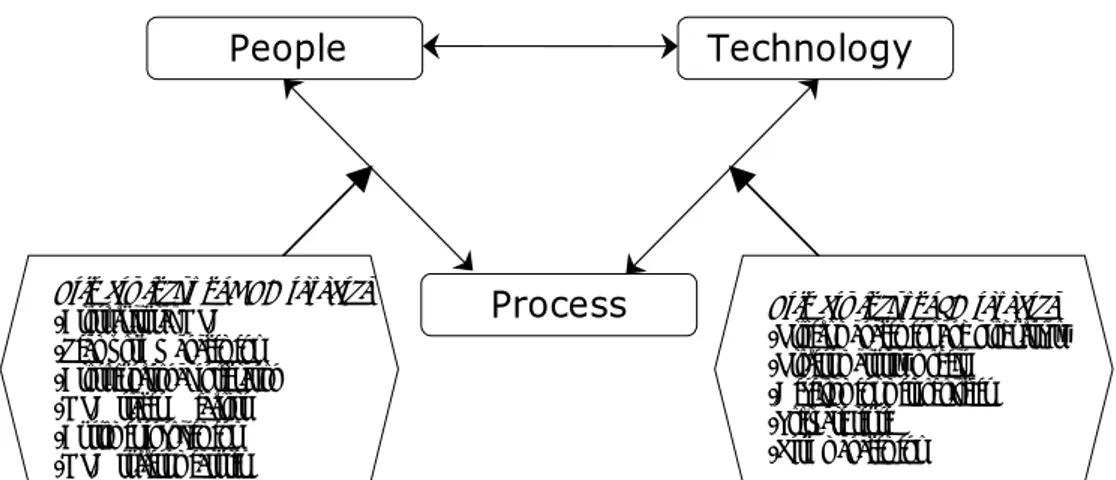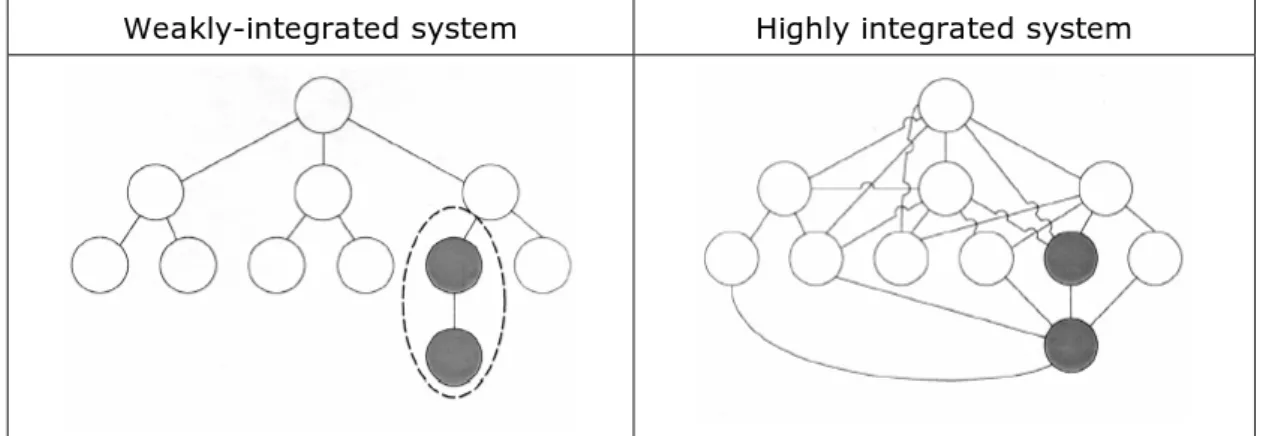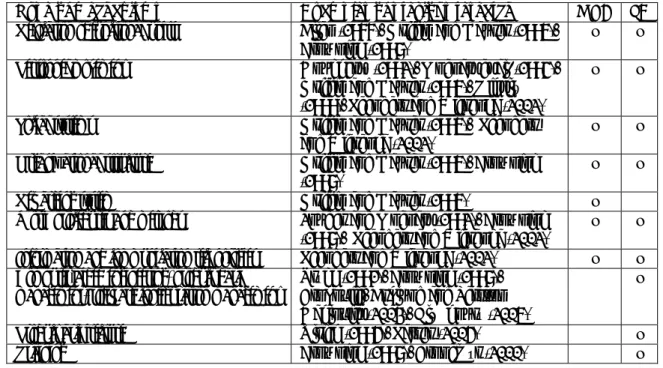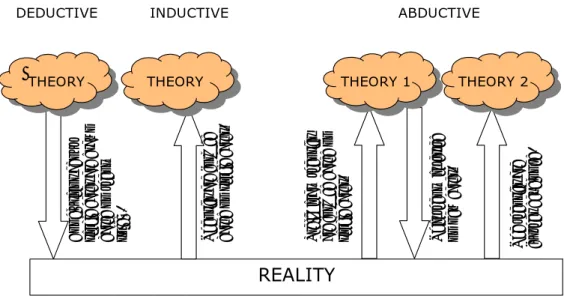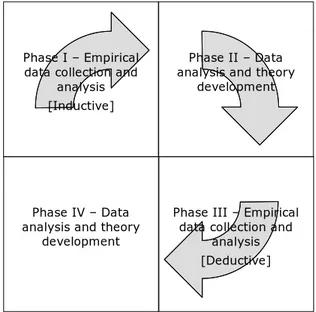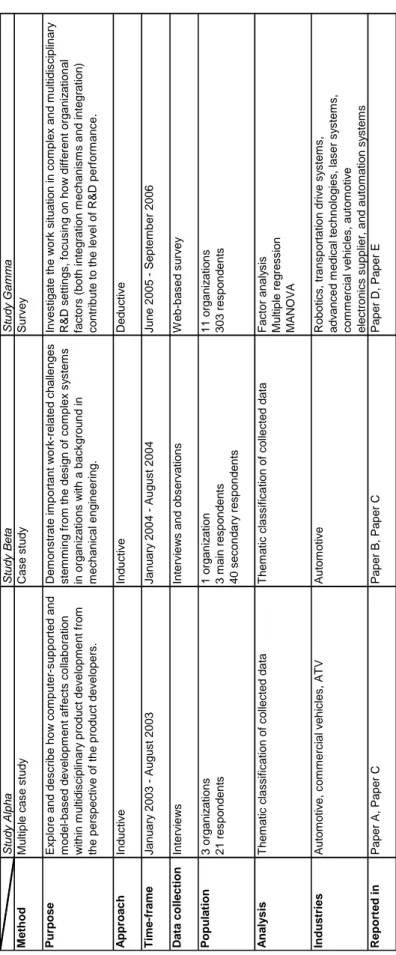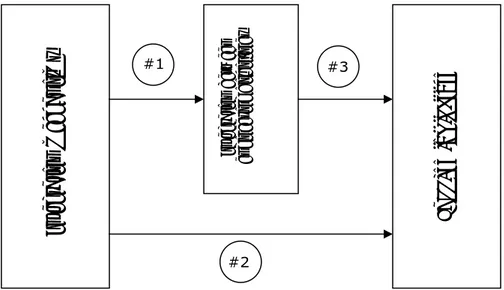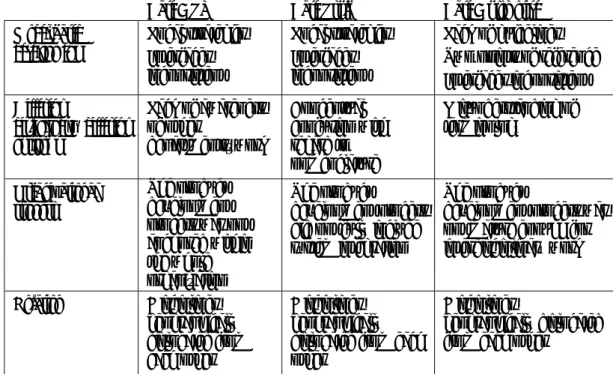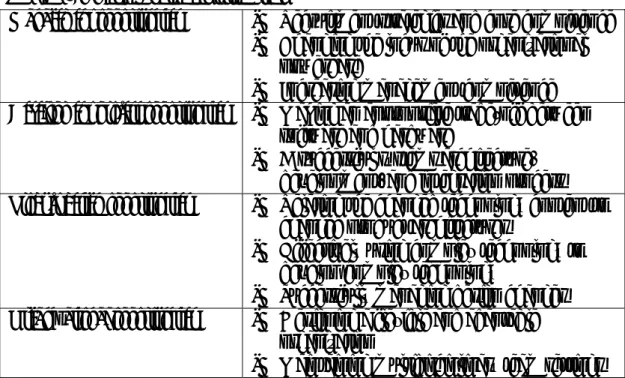Date
Interdisciplinary integration in complex
product development
Managerial implications of embedding software in manufactured goods
TRITA – MMK 2007:04 ISSN 1400-1179 ISRN/KTH/MMK/R-07/04-SE Doctoral thesis
Department of Machine Design Royal Institute of Technology
TRITA – MMK 2007:04 ISSN 1400-1179
ISRN/KTH/MMK/R-07/04-SE ISBN 978-91-7178-610-4
Interdisciplinary integration in complex product development - Managerial implications of embedding software in manufactured goods
Niklas Adamsson Doctoral thesis
Academic thesis that, with the approval of Kungliga Tekniska Högskolan, will be presented for public review in fulfilment of the requirements for a Doctorate of Engineering in Machine Design. The public review is to be held at Kungliga Tekniska Högskolan, Sydvästra
ISBN 978-91-7178-610-4 S-100 44 Stockholm
SWEDEN Document type
Doctoral thesis Date 2007-06-01 Author Niklas Adamsson, (niklasa@md.kth.se) Supervisors
Professor Margareta Norell Bergendahl Professor Martin Törngren
Dr. Annika Zika-Viktorsson
Title
Interdisciplinary integration in complex product development - Managerial implications of embedding software in
manufactured goods
Sponsors
VINNOVA
ProViking - Stiftelsen för strategisk forskning
Abstract
Incorporating electronics and software systems into manufactured goods is becoming very common in manufacturing companies. New technical functions, increased flexibility, and compensation for mechanical design weaknesses are some key drivers of this technological change in our everyday products. The automotive industry exemplifies this trend, since approximately 80–90% of new functions in cars are based on electronics and software, and it is expected that at least a third of the total cost of a car will eventually be accounted for by electronics and software. However, one of the main downsides of this technological trend is the increasing number of quality issues related to these new technologies, something usually claimed to be a result of the increased product development complexity.
Previous research into product development management has mainly concentrated on either physical products or software systems, but not concurrently on both. Additionally, much of the research has concentrated on issues of integrating marketing, R&D, and manufacturing in these companies, and has treated the engineering disciplines in R&D as a homogenous group. Motivated by this change in technology content and the lack of research into complex product development and especially into integration between engineering disciplines, the present work investigates how to increase operational performance in multidisciplinary engineering organizations. This work has especially focused on interdisciplinary integration and the feasibility of various so-called integration mechanisms, such as building common physical facilities, job rotation programs, the implementation and use of information and communications technology, and computer-aided engineering tools.
Both qualitative and quantitative research has been performed, involving 11 different companies and over 300 respondents. Supported by the present findings, it is demonstrated that interdisciplinary integration is a crucial factor to consider, and it is concluded that certain integration mechanisms stand out as more important than others. Organizational structure, work procedures and methods, training, social systems, and computer-aided engineering were the five types of mechanisms that displayed the greatest potential for improvement.
It is further concluded that the ability to successfully match the body of practices to current products is essential, since there is a high risk of current practices becoming out-dated with respect to the technology content. Furthermore, inadequate identification of or managerial ability to establish the currently most important interfaces complicate the choice of trade-offs between various technologies that are found to be essential to cope with the inherent dynamic complexity. The organizational powerbase is often re-positioned in the studied organizations, and the loss of decisive power can result in a demoralizing ignorance of newly established disciplines and their design practices. Additionally, rigid structures and counterproductive traditions can reduce the potential gains accruing from new boundary-spanning innovations, so organizational responsibilities and mandates must be declared unambiguously, in many cases differently from how they have been in the past.
Based on these conclusions, it is suggested that managers in organizations like those studied must be able to do the following: cultivate software knowledge in all parts and levels of the product development organization; reassess their recruitment strategies; organize for interdisciplinary collaboration; articulate and communicate the technology fusion strategy to all disciplines; and realize and disseminate the fact that product launches do not only concern manufacturability.
The Acknowledgments section is usually one of the most-read parts of a thesis. I would thus like to take this opportunity, respectfully, to mention those who made this research possible and who have supported me throughout the process.
Without inspiring supervisors, my research would probably have been quite dull. Margareta Norell Bergendahl, Annika Zika-Viktorsson, and Martin Törngren − you have all inspired me and taught me a great deal. Margareta, thank you for letting me into the complicated but astonishing world of research. Annika, you have invested much time in my work: I am thankful for both your never-ending support and your rigorous work. Martin, thank you for making the intriguing world of mechatronics accessible and understandable to me.
A special thanks goes to Svante Hovmark who helped me in the final phases of this research—I am grateful for all the knowledge you shared with me. A special thanks is also due to Matti Kaulio, who conducted an ambitious, instructive, and greatly appreciated pre-seminar for this thesis.
One critical aspect of research is funding. I am therefore thankful to the parties that financially supported this research project, namely, VINNOVA, the Swedish Agency for Innovation Systems, and the ProViking research program, which is under aegis of SSF—The Swedish Foundation for Strategic Research. This work could not have been accomplished without the full commitment of the participating companies and their employees. You remain anonymous in this thesis, but still I would like to express my appreciation for all information and time that you shared—thank you.
Throughout the thesis work, my colleagues at KTH have been an important source of inspiration. To my colleagues in the division of Integrated Product Development—Diana, Ernesto, Gunilla, Ingrid, Jenny, Lasse, Sofia—thank you! A special acknowledgement goes to former colleague Per Sundström, for much-appreciated support throughout the process. Being part of KTH Machine design is a privilege, especially with so many colleagues, current and former, who have provided such a fun and friendly work environment—especially at the Friday beer sessions. A special thanks goes to Martin Grimheden, Jad El-khoury, and Ola Larses, who have all made my stay at KTH Machine Design extra joyful! To my new room mates in A419 I would like to say: Keep up the good work!
I have had an opportunity to get to know many inspiring people all around the KTH campus. In particular, I would like to thank Folke Snickars and all the staff with whom I’ve had the pleasure to work as a member of the faculty board. I also would like to express my gratitude to everyone with whom I’ve had the delight of working when serving on the executive board of Doktorandsektionen. Thank you for the different perspectives on KTH and on research that you all have given me!
constant questioning, strengthened my knowledge of my industrial potential, and has also given me a head-start in my forthcoming career!
Research is by definition an international activity. The warm welcome from Christian Marxt, the Chair for Technology Management and Entrepreneurship, and his colleagues at ETH in Zurich was highly appreciated. The inspiring environment you provided me with for a short but intense period was a high-octane fuel injection, accelerating the completion of this thesis. I hope that in the future I will have the opportunity of making use of the standing invitation to the Skandinavier stammtisch.
To my friends and family in Umeå, Stockholm, and other parts of Sweden as well as around the world—throughout this work you have reminded me that life is not only about research and for this I thank you. To my parents, Anita and PG—thank you for believing in me and for your unending support.
And finally, I would like to thank the person who is the most important in my life, Ulrica—I love you.
Niklas Adamsson Stockholm, April 2007
List of appended papers
Paper AAdamsson, N. (2004). Model-based development of mechatronic systems— Reducing the gaps between competencies? In Proceedings of TMCE 2004: The fifth international symposium on Tools and Methods of Competitive Engineering. Lausanne, Switzerland. Volume 1(2), pp. 405–414.
Adamsson collected all empirical material and performed the analysis, with Annika Zika-Viktorsson as advisor; Margareta Norell Bergendahl and Martin Törngren also played advisory roles.
Paper B
Adamsson, N., Zika-Viktorsson, A. (2006). Challenges and outlooks for software and electrical engineering in traditional mechanical engineering companies—an investigation into workforce implications.
Submitted for publication, February 2006.
Adamsson collected all empirical material and performed the analysis with Zika-Viktorsson as advisor; the paper was jointly written by Adamsson and Zika-Viktorsson, Adamsson being the main contributor.
Paper C
Adamsson, N. (2005). Management of mechatronics engineering—reflections and propositions. In Proceedings of 12th International Product Development Management Conference. Copenhagen, Denmark. Volume 1(3), pp. 35-48.
Adamsson performed the analysis and wrote the paper; Annika Zika-Viktorsson, Margareta Norell Bergendahl, and Martin Törngren played advisory roles.
Paper D
Adamsson, N., Zika-Viktorsson, A. (2007). The relative effectiveness of different mechanisms for integrating engineering disciplines in complex product development.
Submitted for publication, January 2007.
(Notes: A previous version of the submitted paper appears in the proceedings of the 13th International Product Development Management Conference, EIASM, June 11–13, 2007, Milan, Italy.)
Adamsson and Zika-Viktorsson designed the study reported in this paper reports. Adamsson conducted the analysis with support from Svante Hovmark. The paper was jointly written by both authors, Adamsson being the main contributor; comments were provided by Svante Hovmark and Margareta Norell Bergendahl.
Paper E
Adamsson, N., Zika-Viktorsson, A. (2007). Understanding the importance of interdisciplinary integration in complex product development. TRITA-MMK 2007:03. KTH Machine Design, the Royal Institute of Technology, Stockholm.
Submitted for publication, April 2007.
Adamsson and Zika-Viktorsson designed the study reported in this paper reports. Adamsson conducted the analysis with support from Svante Hovmark. The paper was jointly written by both authors, Adamsson being the main contributor; comments were provided by Hovmark and Margareta Norell Bergendahl.
Additional publications
ThesesAdamsson, N., (2005), Mechatronics engineering—New requirements on cross functional integration. Licentiate thesis. KTH Machine Design, Royal Institute of Technology, Stockholm.
Book chapters
Norell, M., Ritzén, S., Adamsson, N., Kaulio, M., Sundström, P., Uppvall, L., (2005), Interne und externe Kooperation in der Produktentwicklung— Praxiserfahrungen. In Schäppi, B., Andreasen, M.M., Kirchgeorg, M., Radermacher, F.-J. (Eds.), Handbuch Produktentwicklung. München: Hanser. (in German)
Journal publications
Törngren, M., Grimheden, M., Adamsson, N. (2007). Experiences from large embedded systems development projects in education, involving industry and research. SIGBED Review, (4)1.
In conference proceedings
Törngren, M., Grimheden, M., Adamsson, N., (2006). Experiences from large embedded systems development projects in education, involving industry and research. In Proceedings of the Second Workshop on Embedded Systems Education, EMSOFT. Seoul, South Korea
Adamsson, N., & Malvius, D. (2005). Formal and informal roles in complex product development. In Proceedings of 2005 IEEE International Engineering Management Conference. St. Johns, Canada.
Hacklin, F., Adamsson, N., Marxt, C., Norell, M. (2005). Design for convergence: managing technological partnerships and competencies across and within industries. In Proceedings of the 15th International Conference on Engineering Design ICED 05. Melbourne, Australia.
Larses, O., Adamsson, N., (2004). Drivers of the model-based development of mechatronic systems. In Proceedings of Design 2004, 8th International Design Conference. Dubrovnik, Croatia.
Törngren, M., Adamsson, N., Johannessen, P. (2004). Lessons learned from the model-based development of a distributed embedded automotive control system. SAE World Congress 2004. Detroit, USA. Paper 04AE-59.
Törngren, M., Johannessen, P., Adamsson, N. (2003). Experiences from model-based development of automotive embedded control systems. In Proceedings of Mekatronikmöte 2003. Gothenburg, Sweden.
Technical reports
Adamsson, N., 2004, Mekatronik—inte bara en teknisk utmaning. Observationer av mekatronikutveckling i en komplex organisation. KTH Machine Design, the Royal Institute of Technology, Stockholm. TRITA-MMK 2004:20 (in Swedish)
Adamsson, N., 2003, Modellbaserad mekatronikutveckling och kompetensintegration— En komparativ fallstudie inom svensk fordonsindustri. KTH Machine Design, the Royal Institute of Technology, Stockholm. TRITA-MMK 2003:40 (in Swedish)
Contents
ACKNOWLEDGEMENTS...V LIST OF APPENDED PAPERS ...VII ADDITIONAL PUBLICATIONS ... IX
1 INTRODUCTION ...1
1.1 Industries in transition: Complex product development settings... 2
1.1.1 The example of the automotive industry... 3
1.1.2 Industrial challenges ... 4
1.2 Motivation ... 4
1.3 Aim and scope of the thesis ... 5
1.3.1 Research questions ... 5
1.3.2 Scope... 6
1.4 Key terms employed... 7
2 THEORETICAL FRAMEWORK... 9
2.1 Managing the engineering organization... 9
2.1.1 New product development ... 10
2.1.2 Software development ... 12
2.1.3 Systems engineering management... 13
2.2 Complexity aspects of product development... 14
2.2.1 Product complexity... 16
2.2.2 Organizational complexity... 17
2.2.3 Process complexity ... 17
2.3 Organizational integration ... 18
2.3.1 Integration and differentiation... 18
2.3.2 Integration mechanisms... 20
2.4 Measuring success in product development... 24
2.5 Concluding remarks about the theoretical framework ... 25
3 RESEARCH APPROACH ...27
3.2 Industrial partners ...28 3.3 Research progress...29 3.3.1 Phase I ...29 3.3.2 Phase II...32 3.3.3 Phase III ...32 3.3.4 Phase IV ...34 3.4 Research quality ...35 3.4.1 Theoretical sources ...36 3.4.2 Validity...36
3.4.3 Generalization of the results ...37
3.4.4 Concluding remarks...38
4 SUMMARY OF APPENDED PAPERS ...39
4.1 Relationships between appended papers...39
4.2 Paper A...39 4.3 Paper B...41 4.4 Paper C...43 4.5 Paper D ...44 4.6 Paper E...46 5 DISCUSSION ...49
5.1 Revisiting the research questions...49
5.1.1 Organizational structure ...51
5.1.2 Work procedures and methods ...52
5.1.3 Training...52
5.1.4 Social systems ...53
5.1.5 Computer-aided engineering...53
5.2 General discussion of the results...54
5.2.1 Management opportunities...54
5.2.2 Development process opportunities...57
5.2.3 Product design opportunities...59
5.2.4 Organizational opportunities ...61
5.3 From cross-functional to interdisciplinary integration: A necessary shift in research focus...62
5.4 Discussion of the research approach ...63
5.4.1 Unit of analysis ...63
5.4.2 Empirical investigations...64
5.4.3 Theoretical foundation...64
6 CONCLUSIONS AND FUTURE WORK...67
6.1 Managerial implications...68
6.2 Future research ...70
1
Introduction
We can probably all agree that many of the products we use every day are getting more and more sophisticated in terms of intelligent functions and IT content. Many of us who used to make simpler repairs to our own cars realize that, due to the increased amount of electronics and embedded software in cars, there are few service or repair concerns that a non-specialist can take care of nowadays.The constant change of the technology content of our everyday products is the starting point for this thesis. That, together with the constant pressure on product development organizations to increase their productivity and the speed with which they release new products, prompted the research. The specific topic of this thesis is managing product development complexity and, more specifically, managing a wide range of engineering disciplines in order to increase an organization’s product development performance.
Some scholars (see e.g. Wiese & John, 2002) refer to the era of product development as multi-disciplinary, meaning that one must get used to coping with multiple engineering disciplines when managing product development activities. Supporting collaboration between these engineers, who differ significantly in background and competence, is thus an everyday task for engineering managers.
This thesis mainly cites the synergistic integration of mechanical, electrical, and software engineering as a recurring and illustrative example of something usually referred to as mechatronics (Harashima, Tomizuka & Fukuda, 1996). However, as Kodama (1992) discussed when he coined the term “technology fusion,” these disciplines will not necessarily be of foremost importance for R&D organizations in the future. Technology fusion “blends incremental technical improvements from several previously separate fields of technology to create products that revolutionize markets” (Kodama, 1992). Since the old maxim “one technology—one industry” no longer applies, companies must incorporate the “fusion” approach into their technology strategies, and not solely depend on technological breakthroughs. For example, engineers and scientists with education in biotechnology and chemistry are becoming increasingly important
for automotive R&D organizations striving to find more fuel-efficient and innovative solutions.
Many dimensions of complexity will be further discussed in this thesis, and these are specifically described in Chapter 2.2. While browsing through this thesis, the reader should bear in mind that the type of complexity that is currently challenging product development is dynamic, meaning that changes in a system often propagate in a way that is nearly impossible to understand completely (Senge, 1990). Opposing such dynamic complexity is detail complexity, which refers to systems where, for example, hierarchical relationships dominate lateral relationships and the implications of design changes are easier to understand and foresee. For example, many new innovations in both consumer and industrial goods are boundary-spanning, in that sense that they encompass several technologies (e.g. mechanics, electronics, and software). This also implies that several organizational boundaries within the R&D organization (e.g. between power train, chassis, electrical and electronics, and software) are being crossed, so several competence areas and engineering disciplines (e.g. mechanical engineering, electrical engineering, and software engineering) are being linked to each other. Hence these boundary-spanning innovations bring a rather dynamic dimension to the complex process of developing new products. This technological shift has naturally transformed the prerequisites for product development work, and thereby also the working conditions of engineers in R&D organizations. It is thus both timely and interesting to investigate how the operational conditions for engineers in these organizations are being affected by the constantly changing technological landscape.
1.1 Industries in transition: Complex product
development settings
Many companies that develop and produce what traditionally are referred to as manufactured goods are affected by this technological change. Robotics, automation, commercial vehicles, tooling, and transportation are just a few examples of industries that have taken advantage of the possible and profitable innovations created by embedding more electronics and software systems into their mechanical products.
Some of the new advantages that can be attained by integrating software, electronics, and mechanics into new concepts include the following (Buur, 1990): new technical functions, extending the range machine control parameters, increased flexibility, compensation for weaknesses of mechanical design or mechanical structure design, and reduced size and manufacturing costs due to physical integration. For example, in some cases it may be strategically right to replace an expensive and precise mechanical subsystem with a synergistic combination of a cheaper but highly advanced control system and a less precise
mechanical system, to obtain both improved system performance and decreased cost.
1.1.1 The example of the automotive industry
One industry where this change is particularly evident is the automotive industry, as mechatronics has been a specific area of interest in that industry for the past 15 years (Ziebart, 1991; Barron & Powers, 1996). The evolution of automotive electronics is depicted in Figure 1, which indicates how the amount of electronics has increased with time. Mechatronic systems in the automotive industry rely on information from several sensors (regarding e.g. wheel speed, steering wheel, and yaw rate), and utilize actuators (e.g. engine, drive train, and brakes), computer networks, and electrical control units distributed across different technical subsystems and technologies. Approximately 80–90% of new functions in cars were electronics-based in 2001 (Steiner & Schmidt, 2001), and it is expected that at least a third of the total cost of a car will eventually be accounted for by electronics and software (George & Wang, 2002). Altogether, more than 600,000 jobs are expected to be created in automotive electronics in Europe alone by 2015 (Dannenberg & Kleinhans, 2004).
Wiring harness 1949 Wires ~ 40 Contact points ~ 60 Wiring harness 1990 Length ~ 3 km Wires ~ 1900 Contact points ~ 3800 Weight ~ 39 kg Wiring harness 1999 3 data bus systems ~ 60 ECUs ~ 110 electric motors Wiring harness 1949 Wires ~ 40 Contact points ~ 60 Wiring harness 1990 Length ~ 3 km Wires ~ 1900 Contact points ~ 3800 Weight ~ 39 kg Wiring harness 1999 3 data bus systems ~ 60 ECUs
~ 110 electric motors
Figure 1 The development of automotive electronics (von Hasseln, 2002).
More and more of brand identity relies on the functions an automotive supplier can provide by implementing sophisticated but highly complex functionality (Dannenberg & Kleinhans, 2004). Consequently, it has become a key issue in the automotive industry to master and manage the synergistic integration of technologies and engineers (Lung, 2001).
One important downside of this emergent change is that the number of quality issues related to electronics and software in the automotive industry has significantly increased (Auer, 2004). For example, in 2003 it was reported that
49.2% of car breakdowns in Germany were due to electrical/electronics (EE) failures (Knippel & Schulz, 2004), and automotive companies have repeatedly been forced to make major and fairly expensive recalls due to electrical and software problems (see e.g. Reuters, 2005-03-31; Göteborgs-Posten, 2006-11-23).
1.1.2 Industrial challenges
First, many products are becoming more multi-technological, and hence getting more complex in terms of number of components, technologies, interfaces, internal and external relationships, and dependencies. It must be stressed that this condition has implications for several phases in a product’s life cycle (e.g. manufacturing and maintenance), not only for the product development phase that is central to this thesis.
Second, the R&D organizations that turn ideas and concepts into feasible products require a different competence profile of the engineering workforce, so more electrical and software engineers are being recruited by manufacturing companies. Simultaneously, these organizations are experiencing increased organizational complexity, as new critical relationships and dependencies arise. These relationships are based on the new technical boundary-spanning functions, and these relationships may have been complicated to foresee and respond to preventively. Similarly, the work flows within the organization have also become more complex, since new activities and tasks must be carried out, activities and tasks that may both depend on and disturb established work processes.
Taken together, one can identify a potential relationship between the increasing product complexity and the increasing complexity of managing a multidisciplinary R&D organization. Many such organizations have regarded engineers as a homogenous group of people, and spent many resources supporting the integration of organizational functions, in particular, collaboration and communication between marketing, R&D, and manufacturing. Great savings and improvements have accrued from this, but it is now critical to focus on how to manage the multidisciplinary R&D organization (inclusive of its different organizational functions and its personnel). This multidisciplinary era of product development requires further knowledge of how to take advantage of new boundary-spanning innovations while still sustaining competitiveness by developing and producing high-performance, high-quality products.
1.2 Motivation
In describing the motivation of this research, the multidisciplinary era of product development and increased product complexity are used as starting points, and the following factors are identified:
- Manufacturing companies integrating an increasing amount of embedded software in their products are somewhat perplexed when it comes to managing product development activities in light of this technological change (Rauscher & Smith, 1995; Karlsson & Lovén, 2005).
- Different disciplines usually perform hardware and software development, and they seldom get the opportunity to share their experiences. The differing working cultures, supporting tools, and educational backgrounds of these disciplines must be carefully managed in order to cope with the increased complexity (Rauscher & Smith, 1995; Karlsson & Lovén, 2005).
- Research into product development management has concentrated on either physical products or software systems, but not on both concurrently or on the integration between the two (see e.g. Joglekar & Rosenthal, 2003; Karlsson & Lovén, 2005)
- Previous research related to engineering management has, with respect to integration, mainly focused on how cross-functional integration between marketing, R&D, and manufacturing—and not between engineering disciplines within the R&D function—could be studied, evaluated, and managed (see e.g. Griffin & Hauser, 1996; Leenders & Wierenga, 2002). It is therefore concluded that there is an emerging need to study the organizational and managerial aspects of multidisciplinary product development; specifically, there is a need to treat the engineering disciplines and the organizational interfaces between them separately.
1.3 Aim and scope of the thesis
The overall aim of this thesis is to investigate and understand how to increase the operational performance of multidisciplinary engineering organizations. By applying new empirical data regarding established theories of new product development performance, also our understanding of the implications for the management of complex product development will be enhanced. The reported research mainly dealt with organizations that integrate embedded software systems into traditionally manufactured goods; however, the intention is to provide results that are applicable to the broader context of complex product development organizations in general.
1.3.1 Research questions
To achieve this aim, two research questions are formulated that should be answered in this thesis. These questions are derivatives, and are thus more general, of the research questions previously formulated and reported in the appended papers.
The first question concerns integration between engineering disciplines and how important it is to strive for it. In short, integration between engineering disciplines refers to a composite that encompasses both interaction (mainly in terms of communication and physical meetings) and collaboration (mainly in terms of collective goals and mutual respect) taken together. A more inclusive discussion of the meaning of integration is found in Chapter 2, Theoretical framework. Since integration between organizational functions has been found to be significant in other organizational contexts, it would be useful to dig deeper and extend this area by seeking to answer:
RQ 1 How does integration between engineering disciplines relate to operational performance in complex product development settings?
The second question concerns various strategies and tools, or so-called integration mechanisms, for effectively integrating engineers across teams and groups within an organization. This could, for example, refer to building common physical facilities, job rotation programs, and implementing and using information and communications technology (ICT) or computer-aided engineering (CAE) tools. A more inclusive discussion of integration mechanisms is found in Chapter 2, Theoretical framework. Since it is known that the feasibility of various mechanisms may vary in terms of their effects on organizational integration and product development performance, it would be useful to delve deeper into and extend this area by seeking to answer:
RQ 2 What are the differences between the feasibility of different integration mechanisms in complex product development?
1.3.2 Scope
In contrast to much previous research, which has studied the interfaces between organizational functions such as R&D, manufacturing, and marketing, the present research assumes a micro-level perspective by solely considering the context of an R&D organization. This will enhance our understanding of how technology fusion affects the work situation of the engineering workforce and their opportunities to discharge their responsibilities productively.
As previously mentioned, this research cites mechatronics design as a recurring example; however, it is important to note that the primary focus of this work is technology fusion as an approach, rather than mechatronics as a technical solution per se. This emphasis mainly stems from uncertainty as to what technologies will be included in the next generation of manufactured goods. The unit of observation chosen for this research comprises engineers’ experiences and attitudes regarding organizational factors believed to influence operational engineering work. Furthermore, the unit of analysis is operational work in engineering organizations; this is admittedly a rather operational
focus—appropriately so, given the aim of investigating how to improve operational performance in multidisciplinary engineering organizations.
The present research embraces multiple facets of engineering management, not solely specific managerial strategies (such as team work, project management, or computer-aided engineering tools). Much research has examined specific solutions; in contrast, the present research aims to take a wide-ranging approach by exploring, evaluating, and comparing different managerial approaches within the context of complex and multidisciplinary R&D organizations. However, it is still important to bear in mind that there are relationships and interfaces other than those studied here; these excluded relationships and interfaces include both intra-organizational (e.g. between R&D, marketing, and manufacturing) and inter-organizational (e.g. relationships with suppliers) ones.
1.4 Key terms employed
To facilitate reading this thesis, some key terms used are presented and defined in this section; many of these terms are multi-faceted, and this section explains how to interpret them in the remainder of this thesis.
Complexity:1 Difficulties and uncertainties posed by the number of
technologies/components/functions involved in development efforts and by the nature of the organizational tasks that individuals and organizations face in carrying out product development
Complex products: Products distinguished by a large number of elements, a large number of interactions and interfaces, and/or a high level of heterogeneity Cross-functional integration: The state and quality of interaction and collaboration activities that involve two or more organizational functions
Discipline: A specific area of knowledge related to an engineering profession, for example, mechanical engineering or electrical engineering.
Function:2 1) What an element of a product or a human actively or passively does
to contribute to a certain purpose; 2) a defined entity of an organization that discharges responsibilities for a specific purpose.
Integration: Interaction and collaboration involving two or more entities, enabling them to work more effectively together
Integration mechanism: A strategy, measure, or tool that can be used to integrate engineers across teams and groups in an organization
Interdisciplinary integration: The state and quality of interaction and collaboration activities that involve two or more engineering disciplines
1 This definition comes from Kim and Wilemon (2003) and refers to product development complexity. 2 Readers should note that function is presented with a two-fold definition. This is necessary, as the
work refers to both technical and organizational functions; in subsequent uses, the context will clearly indicate which explanation is referred to.
Interface: The locus where two subjects or events interact with each other Multidisciplinary: Involving two or more disciplines
Operational performance: Measurable outcomes relative to stated operational goals Subsystem: A subset of a system
Synergy: Additional benefit produced by a combination of two or more entities (e.g. organizations, humans, and technical components)
System: A defined group of parts that work together as a whole for a particular reason
2
Theoretical framework
This chapter provides insight into some general theories of product development, systems engineering, and engineering management, all of which have been capitalized in the appended papers and used as the theoretical foundation for the discussion presented later in this thesis. Since there is no universal, unifying theory of managing engineering organizations, this chapter should be treated as presenting a framework for the empirical work.The chapter consists of two parts. The first part aims at describing the theoretical context and foundation of the research, presenting a brief overview of the fields of new product development, systems engineering management, and software development. These fields form the “big picture” that provides the background to the various theoretical fields on which this thesis relies.
The second part of the chapter narrows down the theoretical context to certain specific areas used in the operational parts of the research. This includes an overview of the complexity aspects of product development, especially product, process, and organizational complexity. Since integration is a central issue in this thesis, much of this section considers the issue of organizational integration, in terms of content, barriers, and means of support. This section also reviews various measures used in previous research to rate product development performance.
2.1 Managing the engineering organization
Engineering management is an intricate management process, since it is both multi-functional and multi-facetted. It involves a mixture of the somewhat disparate elements of creativity and structure, wherein the main objective is to turn good ideas into new value in the form of new technologies, new products or services, better processes, customer value, and new business concepts.
Due to the multiple facets of engineering management, several research areas claim to offer unique insight based on their frames of reference and viewpoints. More technical and methodical viewpoints are often expressed in research originating from the engineering and operational communities, while a
managerial viewpoint is usually articulated by organizational theorists or organizational development researchers. A customer-oriented perspective is naturally given by the marketing research community, a community that sometimes also embraces innovation aspects. Innovation is a theme frequently found in psychology literatures, but also regularly made use of by many research areas.
Three different research areas related to engineering management, and of particular interest in the context of this thesis, are further described in subsequent sections; these are 1) new product development, 2) software development, and 3) systems engineering management. All three areas are tightly coupled to engineering research, especially software engineering and systems engineering management, which both originate from engineering research communities. New product development (NPD) assumes a broader perspective, although it is still tightly coupled to engineering, since it embraces marketing, management, and engineering—the last in the form of both R&D and manufacturing. These three domains constitute the perspective that informs this thesis; it is neither solely an engineering nor a management perspective, but should rather be seen as a cross-domain perspective.
These three domains have evolved rather independently, with few cross-domain research initiatives to be found. As well, few comparative studies have been made, Nambisan and Wilemon (2000) being one exception that compares new product development research and software development research in an attempt to find opportunities for cross-domain knowledge sharing. These authors conclude that there have been significant differences in focus between the two types of research (Figure 2).
New product development research has commonly concentrated on investigating factors relating to people and processes in product development activities, whereas software development research has primarily concentrated on investigating factors relating to the use of technology and processes to improve software development. Both systems engineering and engineering management are typically taught in the same academic environments in the US (Farr & Buede, 2003). The links between the two areas are generally rather tight but natural, since systems engineers usually have both a managerial and a technical role (Stevens, Brock, Jackson & Arnold, 1998).
2.1.1 New product development
The Product Development Management Association (PDMA) describes new product development (NPD) as the overall process of strategy formulation, organization, concept generation, marketing plan creation and evaluation, and commercialization relating to a new product. Although, NPD itself is not a specific solution; it should rather be seen as a general theoretical domain that invokes different approaches to realize this process.
Figure 2 An illustration of the divergence in research focus between new product development and software development (from Nambisan & Wilemon, 2000).
One approach that has gained much research attention is “integrated product development” (see e.g. Andreasen & Hein, 1987; Norell, 1992; Wheelwright & Clark, 1992), which has been found to be one of the most significant trends in the management of new product development in the 1990s (Gerwin & Barrowman, 2002). Integrated product development is a management approach to improving new product development performance, which occurs in part through the overlap and the interaction of certain activities in the new product development process. Three main approaches to integrated product development were identified by Gerwin and Barrowman (2002). The first approach concerns organizational design in terms of structural adaptations to environmental and technological factors (see e.g. Adler, 1995). The second approach considers integrated product development as an information-processing process that aims to solve problems so as to allow market opportunities and technological possibilities to form a product solution (see e.g. Clark & Fujimoto, 1991). The third approach originates in total quality management principles, in which such aspects as incremental development and the virtual incorporation of suppliers and customers into the organization have their roots (see e.g. Clausing, 1994).
Another approach, which is strongly related to integrated product development, is “concurrent engineering”. The purpose of concurrent engineering, as described by Sage (1992), is to compress the product lifecycle by implementing different parts of the development phase of the lifecycle concurrently. During its development as a research area, concurrent engineering has often focused on computer-aided engineering and its applicability (see e.g. Bryan & Sackett, 1997; Eric, 1997; Burr, Vielhaber, Deuber, Weber & Haasis, 2005).
People
Process
Technology
Primary focus of NPD research
- Cross- cultural NPD - Teamwork Management - Cross- functional integration - NPD stages & factors - Customer involvement - NPD success measures
Primary focusof SD research
-Project management and productivity -Process maturity models -Development methodologies -Software reuse -Risk management
Most research into new product development has primarily related to what has traditionally been referred to as manufactured goods, in that it has emphasized traditional manufacturing companies (Rauscher & Smith, 1995). Nambisan and Wilemon (2000) identified some key research areas that have been covered by research related to NPD (see Table 1) when they compared new product development research and software development research.
2.1.2 Software development
A great deal of management research into software development (SD) has so far focused on large stand-alone software projects, making few or no connections to development of hardware (both electrical and mechanical hardware). There is, however, some research into the co-design of software and hardware, but it includes few or no management considerations; instead, it focuses on development methodologies and technologies, modeling techniques, and similar aspects of co-design (see e.g. Staunstrup & Wolf, 1997; Artist, 2003).
Much research into software development has so far also focused on development methodologies, for example, Rational unified process (RUP) (Lunell, 2003), object-oriented techniques, and technology use (e.g. computer-aided software engineering). That, together with other research topics identified in the comparative research of Nambisan and Wilemon (2000), is listed in Table 2. These authors also determined that project management tools and techniques, including numerical productivity metrics, were research areas that evolved as software development became more complex.
Among the topics that have attracted considerable interest and been found to be applicable in software development organizations are various capability maturity models. The capability maturity model for integration (CMMI), for example, is a process improvement approach that provides organizations with the essential elements of effective processes (Chrissis, Konrad & Shrum, 2003); it can be used to guide process improvement throughout a project, division, or entire organization.
Table 1 New product development research areas as identified by Nambisan and Wilemon (2000)
- Cross-functional integration - Teamwork management
- External and internal communication in teams - Project leadership
- NPD success measures - NPD processes
- Factors that influence multiple stages of NPD - Customer involvement
- Accelerated product development - Cross-cultural NPD practices
2.1.3 Systems engineering management
A third relevant research domain is “systems engineering”, which is rooted in the American defense industry. Systems engineering started to develop in the 1960s to cope with the development and deployment of complex defense systems. It is now an established industrial and academic domain (it is still most strongly rooted in the US), one that takes a rather formal approach to manage complex systems development, strongly emphasizing architectural design and requirement management (US Department of Defense, 1974; Stevens et al., 1998; INCOSE, 2004).
The principal meaning of systems engineering has been long and well debated. Some scholars interpret it as referring to the interdisciplinary tasks required throughout a system’s lifecycle to transform customer needs, requirements, and constraints into a system solution (IEEE, 2005); others interpret it as having a more basic meaning than that, namely, bringing a need into being (Blanchard & Fabrycky, 2006). However, it is apparent that the systems engineering community usually uses the technical system and its surrounding systems (e.g. the logistics, sourcing, development, and deployment systems) as the main reference points on which all activities depend (see e.g. Sage & Lynch, 1998). Analyzing the content of systems engineering research reveals that this domain can be positioned somewhere between new product development and software development, since it focuses on both organizational practices and on more formalistic techniques and methods (e.g. architectural design).
One part of the systems engineering literature covers managerial issues, in most cases referred to as “systems engineering management”, emphasizing organizational settings and how efficient teamwork can be supported in systems engineering. Systems engineering focuses on three main objectives (Sage & Lynch, 1998) that are believed to be causally linked: 1) integrate people, organizations, and technology into multifunctional, networked teams; 2) increase the quality and timeliness of decisions; and thereby 3) completely satisfy customers through providing high-quality products and services that fulfill customer expectations and needs.
The organizational practices described in the Systems Engineering Handbook published by INCOSE (2004) mainly relate to and emphasize design teams and
Table 2 SD research areas identified by Nambisan and Wilemon (2000) - Development methodologies and technologies - Software project management and productivity - Development process maturity
- Risk management - Software re-use
the systems of different teams that need to interact and collaborate to manage complex systems. One of the most strongly emphasized factors contributing to successful systems engineering management is efficient teamwork, especially so-called integrated product development teams (IPDT) (Browning, 1998, 1999; INCOSE, 2004). Such teams are primarily cross functional, in that they include representatives of different organizational functions, such as manufacturing, R&D, and purchasing. Usually they are also part of a system of teams, meaning that a number of teams are organized so as to parallel the hierarchical structure of the product, which in turn depends on how the product is assembled and integrated (INCOSE, 2004). In these teams, each function takes on a different role in the teams’ work and contributes to the overarching product development project, usually on the basis of the project’s current phase. To balance the interests and responsibilities of the teams within the system of teams, a systems engineering and integration team (SEIT) may be established. The primary responsibility of such a team is to manage technical systems issues and to balance requirements between product teams.
2.2 Complexity aspects of product development
No generally accepted definition of complexity is found in the literature. One certain thing is that the original Latin word complexus denotes entwined or twisted together, so to have something that is complex requires two or more components that are joined in such a way that it is difficult to separate them. Similarly, the Compact Oxford English Dictionary of Current English (Soanes, 2003) defines “a complex” as something consisting of many different and connected parts, something complicated and not easy to understand.
Regarding complexity and product development, there seems to some confusion since several different concepts, namely, product complexity (see e.g. Griffin, 1997), project complexity (see e.g. Larson & Gobeli, 1989; Baccarini, 1996), and technological novelty (see e.g. Tatikonda & Rosenthal, 2000), are used interchangeably in the literature (Lebcir, 2006). One definition that takes product development into consideration is provided by Kim and Wilemon (2003, p.16); they define complexity as follows: “the difficulties and uncertainties, posed by the number of technologies/components/functions in development efforts and the nature of the organizational tasks that individuals and organizations face in carrying out product development.”
Three different dimensions of complexity related to product development are specifically highlighted and described in the subsequent sections: 2.2.1— Product complexity, 2.2.2—Organizational complexity, and 2.2.3—Process complexity. These three dimensions are often discussed in research into engineering in general, as decisions regarding one of the three dimensions are often reflected in the other two. Eppinger and Salminen (2001) even postulate that industrial firms in which the patterns of interaction among these three
dimensions are well aligned should outperform firms in which these patterns are not well aligned.
The relationship between uncertainty and complexity is often discussed (see e.g. Shenhar & Dvir, 1996; Kim & Wilemon, 2003; Karlsson & Lovén, 2005). Kim and Wilemon (2003) argue that uncertainty is related to the procedural complexity faced in the new product development process, and Karlsson and Lovén (2005) propose that the number of technologies, components, or functions generate uncertainty (as well as complexity) in product development. Senge (1990) formulated two important concepts that will be further discussed in relation to all three dimensions, namely, detail complexity and dynamic complexity. The first refers to systems containing many identifiable variables or components that are not strongly interconnected. The latter refers to systems where cause and effect relationships are more subtle, and where the effects over time of interventions are not obvious. The differences between the two concepts are further described in Table 3. In a similar vein, Baccarini (1996) distinguishes between two types of complexity: differentiation—the number of varied elements, for example, tasks, specialists, organizational units, and components; and interdependence or connectivity—the degree of interrelatedness between these elements. As a result, a high degree of differentiation concurrent with a low degree of interdependence would indicate the presence of detail complexity, while the reverse would indicate dynamic complexity. A high degree of differentiation could also be found in a situation of dynamic complexity, as long as a high level of interdependence is apparent.
Table 3 Characteristics of detail and dynamic complexity, according to Senge (1990) as presented by Calvano and John (2004).
Detail complexity Dynamic complexity
- Hierarchical relationships dominate lateral influences.
- Cause and effect are relatively obvious and direct.
- The implications of design decisions are relatively predictable.
- Risks are dominated by the local risks in achieving the contributing parts. - Influences on, and implications of, decisions tend to follow the local partitioning of the solution elements.
- Lateral influences dominate hierarchical relationships.
- Cause and effect are not obvious and direct.
- Small causes can have large effects. - The implications of design decisions
are much less predictable.
- Risks are dominated by system risks, with unforeseen emergent properties. - Influences on, and implications of,
decisions are much more difficult to bound and to establish.
2.2.1 Product complexity
Various dimensions of product complexity have been discussed by several researchers (see e.g. Flood & Carson, 1988; Hobday, 1998; Beckerman, 2000; Eppinger & Salminen, 2001; Weber, 2005; Lebcir, 2006).
Differentiation mainly refers to such things as the number of components and levels of subsystems, whereas interdependence mainly refers to the number of interactions and interfaces in a technical system. The level of technical heterogeneity has come to play a steadily increasing role adding to the level of complexity (Larses, 2005) as more and more technologies are integrated into products (Weber, 2005). Other aspects of product complexity identified by Hobday (1998) are the degree of customization of both system and components, number of design choices, elaborateness of system architecture, range and depth of knowledge and skill inputs required, and variety of material and information inputs.
Hobday (2000) states that some products can be categorized as extremely complex, embodying many highly elaborate, customized subsystems and components, and involving new knowledge and multiple feedback loops in both design and production; furthermore, he refers to these systems as complex products and systems (CoPS). These can be distinguished from simpler or even merely complicated products in which the architecture is relatively straightforward, the components are relatively few in number and usually standardized, and the degree of new knowledge required for each product is relatively constrained.
Weakly-integrated system Highly integrated system
Figure 3 The impact of design decisions on components of highly integrated systems can be felt system wide (from Calvano & John, 2004)
Calvano and John (2004) propose that so-called weakly integrated systems (meaning systems that can easily be decomposed into smaller parts while still capable of being considered large-scale systems) typically display the characteristics of detail complexity. They also mean that highly integrated systems (which exhibit more complex interactions throughout the system than
simpler and more weakly integrated systems do) exhibit the characteristics of dynamic complexity, especially since the lateral influences and interactions are very strong and important (see Figure 3).
2.2.2 Organizational complexity
The function of an organizational structure is mainly to describe reporting relationships, allocation of responsibility and authority to make decisions, and allocation of different tasks. A complex organizational structure displays two different kinds of attributes, namely: 1) the greater the differentiation the more complex the organization (Hall, 1979), and 2) the greater the operational interdependencies the more complex the organization (Baccarini, 1996).
The differentiation attribute has two dimensions (Baccarini, 1996). Vertical differentiation refers to the depth of the organizational hierarchical structure, i.e. the number of organizational levels (Hall, 1979). Complementarily, horizontal differentiation refers either to division of labor/personal specialization or to the number and diversity of knowledge resources assigned (Swink & Calantone, 2004).
The other attribute is the degree of operational interdependence. Thompson (1967) defines three different types of interdependence between organizational units: 1) pooled, 2) sequential, and 3) reciprocal. All organizations display pooled interdependence, meaning that each part renders a discrete contribution to the whole and each is supported by the whole. Another type is sequential interdependence, which means that one part cannot act before another has finished its tasks. The third type, which also makes for the greatest complexity (Thompson, 1967), is reciprocal interdependence, which refers to a situation in which one part is dependent on the output of another.
2.2.3 Process complexity
Process complexity is in some cases referred to as technological complexity (Baccarini, 1996); this can be defined as the transformation processes that convert inputs into outputs, processes that involve the use of material means, techniques, knowledge, and skills.
Process complexity can refer to the degree to which a process is difficult to analyze, understand, or explain. By citing differentiation, process complexity can be described by the number of separate actions or tasks needed to produce the end product, and also by the number of variables that must be taken into account (Eppinger & Salminen, 2001). Process complexity, however, also encompasses interdependencies (Baccarini, 1996): between tasks, within a network of tasks, between teams, between different technologies, and between inputs. As with organizational interdependence, technological interdependence can be one of three types: pooled, sequential, or reciprocal (cf. Thompson, 1967). In
addition, the meaning of process complexity also inheres in the coordination of tasks and the required feedback loops (Hobday, 1998).
2.3 Organizational integration
The technical novelty and complexity of product development projects involving several engineering disciplines and organizational functions require that a wide range of expertise must be integrated in a resource-efficient but high-performance fashion. Different engineering disciplines are usually, but not necessarily, divided into different functional departments and do not get the chance to meet regularly. Much research attention in this area has been devoted to the interfaces between marketing, manufacturing, and R&D, where the positive effects of different types of integration mechanisms have been identified (Hoegl, Parboteeah & Gemuenden, 2003).
2.3.1 Integration and differentiation
The concepts of organizational integration and differentiation have been debated long and well. Some of the classic research from the 1960s and 1970s (Lawrence & Lorsch, 1967; Thompson, 1967; Galbraith, 1973) discussed the dynamics of these concepts, and laid the groundwork for much of the product development research done in the 1980s and 1990s. One early reference to integration (in organizational contexts), given by Lawrence and Lorsch (1967), runs as follows: “the quality of the state of collaboration that exists among departments that are required to achieve unity of effort by the demands of the environment”. Lawrence and Lorsch (1967) also provided an early reference to the differentiation among units, which they referred to as “the difference in cognitive and emotional orientation among managers in different functional departments”.
Product development research has identified a potential need to integrate various organizational dimensions (Engwall, Forslin, Kaulio, Norell & Ritzén, 2003). Depending on the particular situation, it may, for example, be necessary to establish and support integration between different companies, departments, competencies, simultaneous projects, and/or successive projects drawing on the same resources.
The concept of integration has been widely discussed in the product development research context. Three main research directions are easily recognized. First, some studies have focused on issues of communication and inter-departmental relationships, mainly in terms of information exchange and physical meetings (Carlsson, 1991; Moenaert, Souder, Demeyer & Deschoolmeester, 1994). Other studies have addressed more of the collaboration aspects, focusing on efforts that encourage collective goals and mutual respect through teamwork (Moenaert et al., 1994). The third view regards integration as a composite that encompasses both interaction and
collaboration within a single organizational entity (Kahn & McDonough, 1997; Kahn & Mentzer, 1998). This view has frequently recurred in recent research, implying that interaction is needed in order to achieve collaboration, and that collaboration will slowly emerge from interaction activities (Jassawalla & Sashittal, 1998).
Barriers to integration
There are many barriers to successful integration, most of which are situational. Some general barriers have been identified in previous research, barriers to integration between R&D and marketing, manufacturing and marketing, or even between engineering disciplines.
One recurrent barrier to integration is the different cultures or thought worlds that may be observed in a single organization (Griffin & Hauser, 1996; Bradley, 1997; Karlsson & Lovén, 2005). In the face of difficulties understanding each other’s objectives and motivations, self-contained societies may develop in organizations, giving rise to miscommunication. Differences in terms of time orientation (Lawrence & Lorsch, 1967) may give rise to prioritization problems; for example, preparation time for the manufacturing process is important to mechanical engineers as tools and moulds must be ordered in time to meet the start of production. Software engineers do not face the same time pressures regarding ordering tools, etc., since the manufacturing process for software production is minimal or nonexistent. As different thought worlds develop some language barriers will arise as a consequence. Marketing and R&D have their own set of terms and nomenclature (Lawrence & Lorsch, 1967; Griffin & Hauser, 1996), just as engineering disciplines within R&D develop specific technical jargon and allocate different meanings to similar terms (Bradley, 1997). This of course seriously threatens effective communication, since different disciplines may interpret and describe the same problem in such distinctly different ways, that to an outsider it would seem that they are each describing different problems (Bradley, 1997). Though some of the purported personality differences between disciplines (Griffin & Hauser, 1996; Bradley, 1997) are most likely stereotypes (Griffin & Hauser, 1996), it is still important to deal with them. Even if the stereotypes are not based in reality, the fact that they are invoked by one or more groups significantly threatens mutual understanding. Organizational barriers may also arise due to differences in formality of structure (Lawrence & Lorsch, 1967): since formal reporting relationships and control procedures may differ, the misalignment of such structures could endanger successful integration.
2.3.2 Integration mechanisms
Various means may be deployed to achieve integration, means usually referred to as “integration mechanisms”3 (Nihtilä, 1999). Browning (1998, p. 97) refers
to integration mechanisms as “strategies and tools for effectively coordinating actions across teams and groups within a program” (or organization). He further categorizes integration mechanisms as either integration enablers or integration maintainers, where the first provide for establishment of integration and the latter monitor and facilitate established integration.
There are many studies of how integration mechanisms should be deployed to increase both integration between various organizational functions, and how the integration relates to various performance measures. Usually a contingency and situational approach is taken—most scholars agree that there is no optimum way of deploying integration mechanisms, since the use often invites trade-offs such as trading information and communication technologies to some extent for co-location (Browning, 1998). However, when these studies are compared, they reveal a great variety in terms of scope, context, and research method. As mentioned, most such research has focused on the organizational interfaces between marketing, R&D, and manufacturing personnel. Some of these studies have taken a qualitative approach (see e.g. Nihtilä, 1999), while others have
3 Adler (1995) uses the term “coordination mechanism.”
Table 4 Classification of integration mechanisms with examples of related research (both contributors and main research domains).
Type of mechanisms Examples of previous research NPD SE
Relocation of functional units Allen (1977), Griffin and Hauser (1996),
Browning (1998) x x
Personnel movement Dougherty (1992), Moenart et al. (1994),
Griffin and Hauser (1996), Nihtilä (1999), Leenders and Wierenga (2002)
x x
Social systems Griffin and Hauser (1996), Leenders
and Wierenga (2002) x x
Organizational structure Griffin and Hauser (1996), Browning
(1998) x x
Rewarding system Griffin and Hauser (1996) x
Work procedures and methods Souder and Moenart (1992), Browning
(1998), Leenders and Wierenga (2002) x x
Information and communication technologies Leenders and Wierenga (2002) x x
Computer-aided engineering, product data
management, software configuration management Trygg (1991), Browning (1998), Crnkoviic, Asklund and Persson
Dahlqvist (2003), El-Khoury (2006)
x
Product architecture Ulrich (1995), Larses (2005) x
taken a more quantitative approach (see e.g. Leenders & Wierenga, 2002). Among the few examples of research examining the use of integration mechanisms in multidisciplinary engineering organizations are the case studies performed by Browning (1998). As well, some studies report on the use of integration mechanisms in software development organizations (see e.g. Hoegl et al., 2003) and construction organizations (see e.g. Mitropoulos & Tatum, 2000).
The primary purpose of these mechanisms is to support integration in different kinds of organizations, but they can also directly influence the performance of the organizations using them. Based on a review of relevant research (covering both systems engineering and new product development), integration mechanisms can be classified into ten different groups, which are further discussed in the following sections. The ten groups are presented in Table 4, which includes citations to related research in the research domains (new product development and systems engineering) in which these ten groups have mainly been discussed.
Relocation of functional units
Relocation of physical facilities mainly refers to the relocation of functional units in the physical workspace; it is one of the most researched approaches to cross-functional integration, since it represents an important—and obvious— way to overcome the barrier of physical separation (Griffin & Hauser, 1996). Usually it refers to physical adjacency of integrated product development teams, functional support groups, system teams, and/or project members (Browning, 1998). Findings indicate that co-location of functional units eases the establishment of interaction patterns, especially at early phases of the development process. It has been argued by several researchers that reduced physical distance increases information flow between organizational functions and disciplines (Allen, 1977; Griffin & Hauser, 1996). Today’s global organizations may often find it hard to co-locate (Kahn & McDonough, 1997), and it is important to be aware that co-location is not always positive for the performance of an organization. There is also the option of whom to co-locate, i.e. only key members of a project or all personnel involved in a project.
Personnel movement
Another type of integration mechanism is personnel movement, a technique for improving information flows across functional borders (see e.g. Dougherty, 1992; Moenaert et al., 1994; Nihtilä, 1999). People moving to another function bring with them contextual information that is important for understanding why certain decisions are made (Griffin & Hauser, 1996), especially when there is a lack of documented and formalized process. One important feature of work-rotation programs is that they minimize the negative influences of decisions based primarily on information obtained in one particular local context. However, excessively fast rotation in an organization could pose a threat, since

